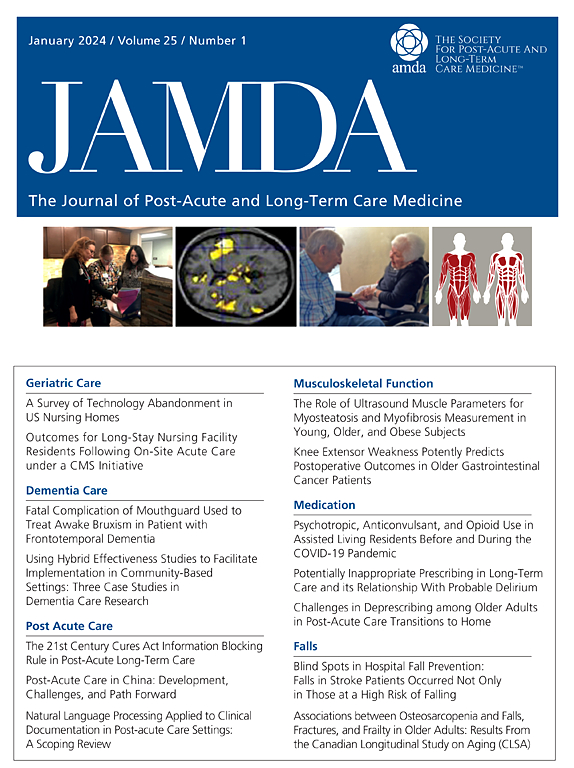Central and Bridging Roles of Social Relationships Within the Multilayer Health Ecology Model in Motoric Cognitive Risk Syndrome: A Network Analysis
IF 4.2
2区 医学
Q2 GERIATRICS & GERONTOLOGY
Journal of the American Medical Directors Association
Pub Date : 2025-07-23
DOI:10.1016/j.jamda.2025.105771
引用次数: 0
Abstract
Objectives
Motoric cognitive risk (MCR) syndrome signals dementia risk in older adults, with social relationships recognized as modifiable influences; however, their interconnectedness with the multilayer factors of the health ecology model remains underexplored. This study aims to investigate the central and bridging functions of social activities, social networks, and social support within the health ecology model in the context of MCR.
Design
A cross-sectional study.
Setting and Participants
A total of 561 community-dwelling older adults with MCR were recruited from the Aging Survey in Mountainous and Island Counties in China. Participants completed the 15-item Chinese version of the social relationships scale.
Methods
Multivariable linear regression was conducted to identify significant associations between the multidimensional aspects of social relationships and the multilayer factors within the health ecology model. These variables were subsequently incorporated into the mixed graphical model–based network analysis to examine structural associations. Network centrality, predictability, and bridging metrics were further assessed to identify key influential nodes.
Results
Mixed graphical model–based network analysis revealed that social networks exhibited the highest values of strength, bridge strength, and predictability, followed by social support and activities. Notably, strong correlations were observed between social networks and education level (≥1 year) (r = 0.635), social networks and self-reported financial status (wealthy) (r = 0.623), social activities and self-reported financial status (wealthy) (r = 0.557), and social support and self-esteem (r = 0.523).
Conclusions and Implications
Social networks, social activities, and social support function as central and bridging roles within the multilayer health ecology model, linking socioeconomic and behavioral factors in MCR. These findings underscore the importance of social relationships as culturally sensitive and modifiable targets for multilevel interventions from a mechanistic perspective, offering a theoretical foundation for practices and policies aimed at slowing MCR progression and promoting healthy cognitive aging.
运动认知风险综合征多层次健康生态模型中社会关系的中心和桥梁作用:网络分析。
目的:运动认知风险(MCR)综合征标志着老年人痴呆风险,社会关系被认为是可改变的影响;然而,它们与健康生态模型的多层因素之间的相互联系仍未得到充分探讨。本研究旨在探讨MCR背景下健康生态模型中社会活动、社会网络和社会支持的中心功能和桥梁功能。设计:横断面研究。环境和参与者:从中国山区和海岛县的老龄化调查中招募了561名社区居住的MCR老年人。参与者完成了15项中文版的社会关系量表。方法:采用多变量线性回归方法,在健康生态模型中确定社会关系的多维方面与多层因素之间的显著关联。这些变量随后被纳入基于混合图形模型的网络分析,以检查结构关联。进一步评估了网络中心性、可预测性和桥接指标,以确定关键的影响节点。结果:基于混合图形模型的网络分析显示,社会网络在强度、桥梁强度和可预测性方面表现出最高的价值,其次是社会支持和活动。值得注意的是,社会网络与受教育程度(≥1年)(r = 0.635)、社会网络与自述财务状况(富裕)(r = 0.623)、社会活动与自述财务状况(富裕)(r = 0.557)、社会支持与自尊(r = 0.523)之间存在很强的相关性。结论和意义:社会网络、社会活动和社会支持在多层健康生态模型中起着中心和桥梁作用,将MCR的社会经济和行为因素联系起来。这些发现从机制的角度强调了社会关系作为多层次干预的文化敏感性和可修改目标的重要性,为旨在减缓MCR进展和促进健康认知衰老的实践和政策提供了理论基础。
本文章由计算机程序翻译,如有差异,请以英文原文为准。
求助全文
约1分钟内获得全文
求助全文
来源期刊
CiteScore
11.10
自引率
6.60%
发文量
472
审稿时长
44 days
期刊介绍:
JAMDA, the official journal of AMDA - The Society for Post-Acute and Long-Term Care Medicine, is a leading peer-reviewed publication that offers practical information and research geared towards healthcare professionals in the post-acute and long-term care fields. It is also a valuable resource for policy-makers, organizational leaders, educators, and advocates.
The journal provides essential information for various healthcare professionals such as medical directors, attending physicians, nurses, consultant pharmacists, geriatric psychiatrists, nurse practitioners, physician assistants, physical and occupational therapists, social workers, and others involved in providing, overseeing, and promoting quality

 求助内容:
求助内容: 应助结果提醒方式:
应助结果提醒方式:


